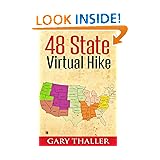Navigation
Navigation for a route where I know the roads is easy. However, I'll use this as an example for navigating more difficult stretches.
Is precise navigation important? Not really. A couple miles either direction doesn't make any difference if not making a turn. Still, a person could get behind their goal distances or overdo it if their estimates on the distance traveled are incorrect. The most important reason for precise navigation is it's fun. None of the people who wrote books about walking across America talk much about it. This post is a first draft and may not be clear. I'll make another post after I practice precise navigation.
The first thing that comes to mind is using the GPS. That's fine for an overnight trip if the person conserves the battery by turning on the GPS briefly every hour or two. It doesn't work for a long trip where fresh batteries may not be available or they would have to be carried. Then there is the problem of the GPS screen being visible in all conditions.
Miles traveled is the basic information needed to determine how far one has traveled on the map. Naturally, a person would use map reading and sign reading skills to make sure they are on the right road.
Ideally, I'd like to have an odometer on Wilson. So far, I haven't been able to find one that fits the wheel. Eventually, I probably will find one, but the search is continuing.
If a person has calibrated a pedometer well, it may be good enough for short distances between waypoints where they could confirm their position on the map using landmarks.
Another way to determine how far a person has walked is to use a stopwatch and a known pace. I estimated my pace will be 3.5 mph on a long walk. I estimated a little lower than my usual pace of about 3.75 mph so I start looking for landmarks before I reach them. The map above is marked every 1.75 miles, or every half hour. Each time I pass a landmark that positively fixes my position, I can write the elapsed time on the map.
If a hiker knows about how far they traveled, they will avoid mistaking their position for a place that is unreasonable for them to be.
I like the idea of a cycle of walking for 50 minutes and breaking for 10 minutes at the next good spot to break. The only reason I like this time is every book and article I've read on long distance marching in the military recommends this cycle. There must be a good reason for it, so that's the pattern I'm going to try for long distances.
I could use a stopwatch, but I hate looking at a stopwatch frequently to see how long I have left to walk. I suppose it could work if I mounted it on Wilson so it could be seen easily. What I'd prefer to have is a simple mechanical egg timer with a bell loud enough to hear over traffic.
What I'll probably do is use a stopwatch and walk until I feel like stopping. About once an hour or when I see prominent landmarks, I'll mark my position on the map. When I mark the position, I'll log the elapsed time and the actual time I leave the position. The last is because stopwatches have a way of misbehaving sometimes.
Mental calculations can be difficult when a person is walking for a long time, so I made a little table to calculate the distance traveled.
| Min | Dist | Min | Dist | |
| 10 | 0.6 | 1 | 0.1 | |
| 20 | 1.2 | 2 | 0.1 | |
| 30 | 1.8 | 3 | 0.2 | |
| 40 | 2.3 | 4 | 0.2 | |
| 50 | 2.9 | 5 | 0.3 | |
| 60 | 3.5 | 6 | 0.4 | |
| 7 | 0.4 | |||
| 8 | 0.5 | |||
| 9 | 0.5 |
Add the first column to the second. For instance, 38 minutes of walking would be 1.8 + .5 or 2.3 miles. I'll put one of these on my navigation table on Wilson.
Navigation table? Why yes. I'll want the map attached to something on Wilson's push bar so I can see it all the time. I envision something like a clipboard mounted with brackets. I don't want to be pulling a map out of my pocket all the time.
After I test this theory for awhile, I'll likely change it.
See you down the road,
Gershon



No comments:
Post a Comment